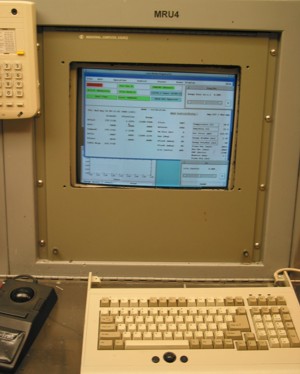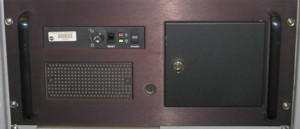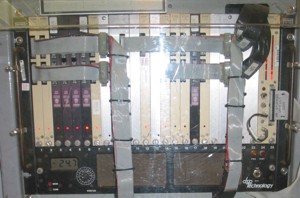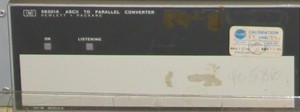
Console of the controller subsystem.
The controller subsystem is a real-time, computer-controlled data handling system that uses a standard 486/50 PC. It controls the T&MC subsystem servo control section to position the mount for ranging operations. It also computes, formats, and records the ranging data based on the computer program and inputs from the other subsystems. Mount positional data from the shaft angle encoders is applied to the controller subsystem for comparison with the programmed positional data. The controller subsystem makes the comparison and generates a correction (error) signal that it sends via CAMAC Crate 6A8 to Servo Interface Chassis #1 (5A3) and #2 (5A4) to reposition the mount. The controller subsystem operational program loads into CPU from its internal disk drive. Keyboard, the track ball, and monitor provide manual operator interface with the computer.

Console
of the controller subsystem.
The subsystem is controlled during ranging operations by the CPU operational program and inputs from the DMS subsystem. The controller computer controls tracking mount positioning through the servo section of the T&MC subsystem. The mount position data from the shaft angle encoders is routed to the controller computer for comparison to the programmed position data. The controller computer makes the comparison and generates a correction (error) signal which is sent via the CAMAC to the servo rack, and on to the mount to correct the mount position.
Central Processing Unit (CPU). The computer is a UNIQ-486. Its CPU is the Intel i80486®, operating at 50 MHz. The computer display is a 17 -inch Super VGA 256 color monitor. In addition to 32 Megabytes of RAM, the PC has two 520-Mbyte disks. The second disk is a backup of the entire first disk; this allows for a quick recovery from a possible system crash. The operational disk is NFS-mounted over the network by the HP computer, which then just reads the satellite data from PC disk's raw data file. Data and software from the PC can be backed up to either the PC's 1/4" cartridge tape or to the HP's optical disk. The PC's tape cartridge is also used to transfer software updates to the field systems from NASA SLR HQ at Greenbelt. System booting can be performed only from the hard or floppy disk, never remotely.

Central
processing unit.
Timing. The timer card is a National Instruments TIO-10. The 1- and 40-pps signals are obtained from the TRAK TCG. The two signals are interfaced to the National Instruments TIO-10 timer card via a 50-pin connector that resides in the UNIQ-486 backplane.
Interfaces. The computer data interfaces are Ethernet, SCSI, CAMAC , GPIB (IEEE ), and serial (RS232).
Ethernet. The Ethernet card (SMC8013) provides connection to the Network. This is the path that the PC and HP use to communicate. Connection with any computer on the Internet is possible from the PC. However, the recommended Network connection with other computers off station is through the HP-380 computer.
SCSI. The SCSI interface (Adaptec 1742B) allows for multiple SCSI devices to be daisy-chained on the bus. The current configuration includes both floppies, both hard disks, and the cartridge tape.
CAMAC . The current CAMAC interface provides for 23 single-slot CAMAC modules. The modules include operator console inputs, encoder positions, servo drive and ranging control, and (for some systems) range return. Note: CAMAC interrupts are not enabled on the MOBLAS systems.

IEEE . The IEEE interface is used in many systems to input the round-trip time-of-flight measurement via the HP-5370B TIU. Acting as an adjunct to the IEEE interface is a parallel-to-ASCII converter that is mounted behind the HP computer.

Serial Interface. The serial (RS-232C) interface connects the computer with the Optical Attenuation Mechanism (OAM), the TCG time-of-year words, and the Paro_Scientific barometer unit, as well as to instrumentation required in future system upgrades.
CAMAC Crate. CAMAC Crate constitutes the major interface between Computer and the rest of the system. Its plug-in modules provide the signals that allow the computer to "talk and listen" to its peripherals in the other subsystems. The CAMAC inputs and outputs include digital inputs and outputs, analog-to-digital (A/D) and digital-to-analog (D/A) inputs and outputs, and a high-speed A/D input multiplexer.